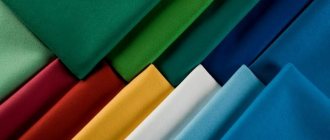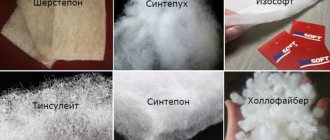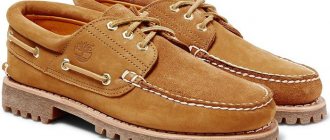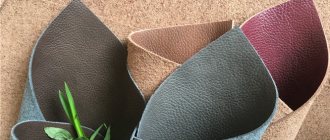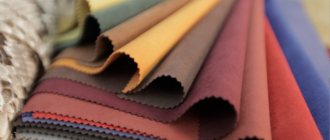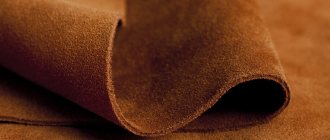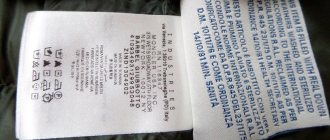Materials with the prefix “eco” are already conquering the world’s catwalks, with models sporting eco-leather, eco-suede and eco-fur. Humanity is slowly “waking up” and Natural furs in America and Europe have already become a sign of bad taste. Our country is a little behind, but Eco-fur has finally reached Russian beauties)
But the podium is one thing, but real conditions, especially in northern latitudes, are completely different. In warmer countries, this is more of a fashion accessory and, although our ladies also want to look luxurious, the practical side is no less, and sometimes even more important, than the beauty of faux fur. Frosty winters do not forgive carelessness. Many are worried - is it warm enough, will I freeze in it, is it harmful to health, and in general - what kind of animal is this?
For several days I “flyed” on the World Wide Web, soaking up information from manufacturers, reviews from those who had already tested the new product, recommendations (I, too, as a super-practical girl living in cold Mother Russia, was terribly curious!). Now I bring everything I have collected to your attention in several articles. This is the first, introductory one. The next one will describe all the rules for caring for eco-fur. Let's begin!
So, eco-furs are already on the shelves of our stores and hundreds of buyers of high-quality faux fur coats are absolutely delighted (oops! spoiler)). Many famous brands and designers use eco-fur in their collections and demonstrate them at world shows, including Alice + Olivia, Stella McCartney, Shrimps, Patrizia Pepe, Sonia Rykiel, Michael Kors, Giamba. Domestic designers are also catching up, for example Katerina Dobryakova and Lyudmila Nikishina.
Eco-fur is firmly in fashion and in the minds of humanity)
And for those who are hearing about him for the first time - get acquainted)
The first artificial fur was “born” back in 1929. Natural fur was glued onto the fabric, but such a “Frankenstein” was capricious and short-lived, which did not contribute to its popularization and this idea was abandoned.
In the early 60s of the 20th century, the technologies of that time began to make it possible to draw fibers from polymers by heating them. This is how the first eco-fur appeared. Low quality and very different from natural, but still deservedly adorned hundreds of women and saved thousands of animals.
Total craze for faux fur in the USSR
Today we have the happiness of using high-tech fabrics, dressing ourselves, pets and interior items in soft luxury without harm to animals . The old and bulky faux fur has been replaced by the brand new Eco-fur.
Eco-fur is a new modern material that very successfully imitates natural fur.
In appearance you can’t tell it from the real thing , it’s soft and gentle to the touch.
What is eco-fur made from?
Now manufacturers have new generation equipment that allows them to make hairs very similar to the hairs of animals. These fine fibers are evenly applied to artificial leather or a woven base made of synthetic and natural threads so that it is akin to natural fur. The fibers themselves are made from nylon, polyacrylonitrile (whatever that means), viscose, and lavsan.
Fur pillows are in fashion now) Eco-fur is made in different ways. These are the most popular: Knitting and stitching “wool” from twisted cord (chenille) is knitted into a woven base. Fabric-stitching tufting machines stitch the base fabric with fiber loops, which are subsequently cut to form “fur.” The material is glued on the reverse side. Woven in the process of making the base fabric, the pile is already woven into it, and after completion it can be glued. Glue (invoice) is one of the main ones. The pile is glued to the base and combed. This method is used to make sheepskin, arctic fox, mink, silver fox, leopard and others. The villi are made short to imitate the undercoat and long to imitate the guard hair. They are “planted” in the same way as animals - the “undercoat” is thicker, the “wool” is thinner, and the result is a very high-quality “fur”. Knitted fabric is knitted on industrial machines with loops, which are glued with film on the reverse side for strength.
Sometimes a special vapor-permeable film is applied to the outer side of the canvas to protect against precipitation. To make it even more “convincing,” Eco-furs are dyed and trimmed “to suit a specific animal.” Sometimes these procedures are purely decorative.
Methods of decorating Eco-fur.
- Plain-dyed - dyeing the pile in one tone along the entire length.
- Melange furs are a method of applying several colors to the fur, most often certain patterns, such as lynx, tiger or cheetah.
- Curling is most often used for sheepskin and astrakhan fur.
- With the help of embossing you can “push through” any patterns. Painting occurs using stencils and sprayers (airbrushes) and, as a rule, is done in layers. Read how to dye fur yourself here
So, Eco-fur is also artificial, like its predecessor, only of much higher quality. It is also called "Eco Fur". To avoid confusion, we will call Eco-fur (the new generation) that, and we will call the old generation simply “artificial”.
How to check in different ways
There are several ways to quickly distinguish natural fur from synthetic fur.
How to determine by touch
Natural wool always feels smooth and soft to the touch. If you run your hand over it, the villi will quickly return to their previous position. You can squeeze the product in your palm and then release it. Natural flesh will instantly return to its previous position, as it has a high degree of elasticity.
You can also notice that this fur is a little itchy. If you run your hand over it, the fibers will pass through your fingers, as if you were petting a cat. It is worth paying attention to the undercoat - it should be quite thick and soft. In addition, the natural material is always a little cool to the touch, and has a beautiful shine when exposed to sunlight.
Don’t forget that the fur of different animals feels different to the touch. Mink hair is quite hard, while beaver hair is very fluffy. The silver fox can be recognized by the presence of three different colors on each hair. And its skin is soft and warm to the touch.
Fire test
Another way to check the naturalness of fur is to set it on fire. This must be done carefully by pulling out a few fibers and bringing the fire to them. When real animal fur is burned, an unpleasant smell of burnt hair will be felt. In this case, the material will burn, leaving behind only ash.
Synthetics will begin to melt, and as a result will turn into a ball of plastic. The process produces a very unpleasant chemical odor. The complexity of this method is that not every seller will allow this experiment. Therefore, you can determine the quality by fire only after purchase.
Pierce with a pin
A pin or needle is another simple method for determining whether the fur you are looking at is real. Use the tip of the tool to carefully pierce the product. In the case of animal skin, the needle will be very difficult to enter, but the artificial fabric base can be pierced quite easily. You also need to pay attention to the hole that remains after the experiment. If you pull the skin in different directions, it should not increase.
Basics test
You can verify its naturalness by carefully examining the base and spreading the hairs apart. In the case of faux fur, it is always fabric, stretchy, you can see threads on it, and this immediately catches your eye. Natural products are distinguished by a smooth leather base. It is also worth paying attention to its color. A high-quality real animal skin will be white or very light, but if it is colored, then most likely it has been dyed.
Important: high-quality fur does not require painting. Often, manufacturers dye and cut it in order to hide any defects.
As you can see, you can always check whether the fur in front of you is natural or artificial. But every year it becomes more and more difficult to distinguish them. Modern technologies allow manufacturers to imitate natural materials as efficiently as possible, which causes many difficulties when choosing a product. In order to correctly identify all the differences and purchase a truly high-quality fur coat or sheepskin coat made of natural fur, you need to be very careful and use all the above recommendations.
Products made from eco-fur - is it dangerous for health?
Times are changing and cheap, smelly synthetics containing a bunch of harmful substances are being replaced by a new generation of modern materials that are safe for people and the environment. Eco-fur is one of them.
- No toxic mixtures are used for its production
- Microbes do not live in these fibers
- Allergy sufferers wear eco-furs completely calmly ; there is no reaction to them.
- Products made from this material can be safely purchased for children, pets and used in home decor, without fear for the health of your loved ones and your own.
- For me, the most important advantage is that it preserves the health of millions of innocent animals
An arctic fox is an arctic fox. And he is wonderful!
Application of Eco-fur.
People's ideas about what fur should be are changing. Humane treatment of animals, humanity and kindness are gradually coming to the fore , which means that fur should not be the cause of massacres . Some cities, and even entire countries, follow advanced views on the origin of this raw material and prohibit the sale of natural furs. However, city dwellers do not deny themselves Eco-furs as luxury accessories, which proves that they are not against fur in general. Let's take a closer look at how you can use Eco fur even in sunny countries.
- Production of clothing - both entirely and only the finishing of sleeves and hoods.
- The shoes are decorated on the outside and insulated on the inside.
- Elegant fur hats and scarves are also popular.
- Fur handbags, collars and eco-fur wallets are now the trend of the season.
- Eco-friendly “skins” can be hung on walls, they can be used to make blankets, bedspreads and pillows , and decorate screens with them.
- Don't forget about fluffy cozy rugs.
- Shaggy ottomans and sofas look interesting and unusual.
- Children have already liked soft toys On the Internet I increasingly come across topics like “how to sew a bunny from eco-fur” or something similar.
It's nice to lie on a blanket made of eco-fur)
Characteristics of natural fur
To understand whether the fur you are being offered to buy is real, you need to understand the types and properties of natural animal fur. Each type of fur is unique in its structure and has individual characteristics.
- Mink . The most sold and popular fur is mink fur. Expensive fur has the softest and silky structure. The mink pile is perfectly smooth and even - this gives each sewn product elegance and sophistication.
- Sable . The next luxurious and elegant fur is sable fur. Sable products are incredibly expensive and not everyone can afford such wealth. The structure of the fur is unique, and if you even once touch sable clothing, you will not confuse this feeling with anything else. Despite modern trends in dyeing and cutting fur products, famous designers prefer not to spoil the natural beauty of fur.
- Arctic fox . The fur of the Arctic fox is long-haired, fluffy and light. Products made from it are luxurious, although they are budget-friendly compared to mink and sable. In nature, there is white and blue scribe; all other shades are artificially colored.
- Fox . The fur of the unique black and brown fox is very valuable and attractive. The density, fluffiness and coziness of this fur attracts attention. The fur is very warm, wear-resistant and practical. And the shade looks advantageous and is suitable for creating all kinds of fur items.
- Rabbit. Rabbit fur attracts with its low cost. Despite the budget, this fur is practically in no way inferior in its wear-resistant qualities and has a varied palette of shades. It is with the help of this fur, namely its cutting and dyeing, that manufacturers counterfeit expensive products.
Fur coat made of natural rabbit fur - Chinchilla . The incredibly light and densely padded fur belongs to the chinchilla. The color of the fur is unique, it shimmers and smoothly changes from dark gray to a bluish tint from the back to the sides, and on the belly it is snow-white. This fur is very valuable, and products made from it are expensive.
- Marten . Marten fur looks a little like sable. However, the marten's spine is thicker and denser, and the cover itself is harsh. This fur is perfect for sewing long fur coats, as well as handbags, hats, collars and other accessories. The advantage of this fur is its natural wide palette, from light gray to dark brown.
Let's sum it up
To choose a genuine fur item, you need to be very careful and have time.
You should not buy the first product you come across and succumb to the persuasion of sales consultants. Remember, you are buying an expensive item and most likely not for one year. [Total: 3 Average: 2.3/5]
Pros and cons of Eco-fur, how it differs from “old” faux fur and from natural fur.
Advantages of Eco material.
- The first and most important thing is to save millions of animal lives . The hunt for these beautiful creatures has already endangered hundreds of species of animals. The Red Book is a disgrace to humanity . In the wild, a few lynxes, tigers, leopards, seals and goats roam alone. By the way, the death penalty is provided for killing a very rare Far Eastern leopard in China .
- It looks as luxurious and “expensive” as natural skin.
- soft and silky to the touch , which is strikingly different from its old brother. I remember this synthetic squeak and plastic hairs - I had similar clothes in which I looked more like a pink furry bun than a princess. Then I reshaped it into a bag, to hell!
- Eco-fur is not afraid of wet and snowy weather . It does not get wet through and dries quickly. When wet, it does not emit unpleasant odors, like fur coats made from natural fur, and does not roll into “icicles” like artificial ones. All you need to do when you get home is to dry it naturally on a hanger, carefully combing the product in the process and there are no problems)
- He is not very picky about his care. It can be safely washed on delicate cycles without spinning in a washing machine. Natural furs are still capricious, and if cleaned, it is exclusively dry and it is better to dry clean them.
- Eco-furs do not pill, do not cake or wrinkle , just like real ones.
- It is lighter than artificial and natural, it is pleasant to wear.
- Eco-furs are warm due to the vapor permeability of the base. They can withstand, according to various sources, from 15 to 30 degrees below zero. It depends on what kind of insulation is used in the product.
- Its wear resistance indicators are much higher than those of old artificial ones, and are the same, and sometimes even superior (depending on the quality of the raw materials) to natural things.
- Manufacturing technology allows you to create material of any thickness, color, style , which only encourages designers to create truly masterpieces. Do you want a golden fleece, or do you want a silver fleece).
- In addition, you can make fabrics of any size, this greatly facilitates cutting, which means that the clothes will have fewer seams , which, in natural fur coats, tend to diverge and stretch over time.
- The moth does not eat artificial furs (she has indigestion), but she happily slurps natural furs along with all the anti-moth bags that we so carefully lay out in our closets. Even if you protect your natural fur coat from moisture and properly care for it - one family of moths... whatever - just one moth can devour your at least 70,000 in a few weeks, making disgusting holes.
- And eco-furs, with all the described advantages, are many times cheaper. If natural fur from, say, mink, will cost from 70,000 rubles, then from ermine it costs 120,000 and more. Prices for “the same” eco-fur coats start from only 15,000-20,000 rubles. Isn't this a wonderful bonus? Just imagine - for 70,000 (which you would spend on 1 natural fur coat) you can buy at least 2 different fur coats and dress them according to your mood. Therefore, chic parkas and eco-fur jackets are now available to any fashionista.
For every taste and color!
Disadvantages of Eco-fur.
- If you run your hand over it, you will distinguish it from the natural one (sometimes not the first time). But if you had nothing to compare with, believe me, the fluffiness and softness of high-quality Eco-fur would leave you with no doubt that this is a worthy material.
- Scientists have not yet achieved the same heat levels as natural fur. But this problem is very easily solved with a more frost-resistant insulation, for example, Tinzuleit (polyester-based), which can withstand temperatures down to -30-40 degrees Celsius, without weighing down or “blowing” the product, like synthetic winterizer. It is thin and warm, and also “breathes”. By the way, mink or rabbit fur, which is often used to make fur coats, has a rather “liquid” undercoat, which is supposed to keep you warm, so in cold weather such a thing is of little use. That’s why they are also additionally insulated.
- If washed incorrectly (over 40 degrees), it may shrink as it may contain cotton fibers. But improper care has ruined many natural products.
- The only negative I would have called electrification if I had lived a couple of centuries ago, but, fortunately, manufacturers of anti-static agents and special anti-static detergents for washing synthetics took care of this too.
- Eco-fur is afraid of high temperatures - over 40 C, so it is not recommended to use it where it can get very hot, for example, on heated seats.
- A high-quality product cannot be downright cheap; you will still have to spend money.
- While the material is new and people know little about it, there is a risk of buying a fake from an old generation of fur, which, of course, will not have all the advantages of Eco-fur. You have to be careful here. Exactly the same as with the purchase of a natural fur coat, which can also climb, shed and unravel if it is poorly sewn or the skins were processed incorrectly. Only in the case of false fur you will lose much less money.
If you wash it incorrectly, your vest is only for a pet)
What is the difference between NATURAL FUR and ARTIFICIAL FUR
With the onset of winter, many people have a desire to purchase a fur product: made from natural or artificial fur. But today modern technologies are so developed that it is not always possible to outwardly distinguish a product made from natural fur from something made from faux fur.
Initially, fur was the name given to animal skin, removed along with the wool and dressed into a fur coat. Natural fur was the oldest material for creating clothing that reliably protected from the cold. In modern production, only the skin of certain animals is called fur. These are the families of lagomorphs, mustelids, felines, fox, beaver, deer, serval and Karakul sheep.
The quality of fur products depends not only on the skin itself, but also largely on the art of manufacturing its inner layer (the uppermost layer of skin adjacent to the fur). The flesh should be thin and extremely soft, but durable.
Natural fur does not get wet and dries quickly away from heat sources. Therefore, it is considered a reliable protector not only in cold weather, but also in wet weather. However, it needs proper storage. The storage location must have good air access to prevent moth larvae from appearing and devouring the fur. It is better to pack the products themselves in loose gauze bags, placing lavender, dried orange peel or wild rosemary herb there, which repels moths. Natural fur can only be cleaned with special equipment.
Fur is divided into smooth and fluffy. Smooth fur is found in animals such as sable, mink, otter, marten, weasel, ermine, ferret, sage, muskrat, squirrel, seal, seal, mole, kids, muton, and Karakul lambs. The most famous fluffy furs : arctic fox, fox, raccoon, nutria, beaver, chinchilla, llama, opossum, sheepskin, rabbit.
Natural fur is an expensive status material. In modern clothing, it is used both for insulation and for ceremonial purposes: to emphasize respectability and high position.
Faux fur is a pile material that is produced in several ways: by glue, on weaving machines or knitting machines.
Most often it is used as an insulating lining or for finishing (cuffs, collars, edges, etc.) inexpensive products made from other materials. Outerwear is also sewn from it - it can be a fur coat or a headdress.
Faux fur is much cheaper than natural fur and does not provide much warmth. Its appearance quite quickly, in just two to three years, becomes less attractive due to felting, and the product may shrink after washing in hot water.
Fur coats made from artificial and natural fur can be practically indistinguishable from each other in appearance. Natural fur is distinguished by the fact that it is smoother and more pleasant to the touch. A product made from natural fur weighs less and shines brighter in the light than one made from artificial fur. In addition, a fur coat made from natural fur will be softer than a similar product made from faux fur. Despite the high cost of natural fur coats, it usually pays off in the long term, since a natural fur coat retains its original appearance longer.
The easiest way to distinguish faux fur from natural fur is to pluck a few hairs from the fur coat and set them on fire. Typically, real fur will catch fire and smell like burnt hair, while artificial fur will start to melt and smell like a chemical. The main and obvious difficulty of this method is that almost any seller will refuse if he is offered to pull out even a few hairs from a fur product. Therefore, the experiment will most likely be carried out only after acquisition.
In addition, reliable methods of checking a product include the base of the fur. If the fur is natural, then you will see the animal’s skin - wrinkled skin, and if the fur is artificial, there will be a loose fabric fabric as the base.
There is also a visual method for identifying natural fur. A careful look at the label usually helps. It must indicate the type of fur from which the product is made and the origin of the fur. All inscriptions must be written legibly, the font should not “float”.
Conclusions:
- Natural fur is lighter, softer and has a special shine, shimmering in the light, unlike artificial fur.
- Natural fur requires special storage and care.
- When properly stored, natural fur can last for decades without changing its original appearance. Faux fur loses its attractiveness after two to three years.
- Faux fur, unlike natural fur, is not damaged by moths.
- Natural fur is a status material that indicates the high position of the owner of the item. Due to the complexity of obtaining raw materials and, especially, high-quality manufacturing, natural fur is much more expensive than artificial fur.
- Natural fur burns, emitting a specific smell of burnt hair, but artificial fur does not burn, but melts, giving off a chemical smell.
- The base of a natural fur product consists of animal skin, which usually has a wrinkled appearance, while the base of a faux fur product consists of a loose fabric fabric.
- The label of a product made from natural fur must contain information about the type of fur and its origin. All writing must be clear and legible.
- Natural fur is more expensive than artificial fur.
How to identify high-quality eco-fur?
- The first thing you should pay attention to is the uniformity of coloring . If you see stains, dark or light spots, refuse to purchase. Most likely, the production and dyeing technology was violated and in the future the pile may begin to shed or climb.
- Smell the product . If you smell sharp, chemical or other unpleasant odors, it is a fake or there were serious technological violations during the production process. Look for another store.
- Run a damp hand or cloth over the fur. You need to make sure that the lint does not fall out . You can lightly tug the fibers to see if they sit firmly on the base.
- The product must have a label from the manufacturer with information about the composition and methods of care. The most durable is considered to be pile or polyester.
- Inspect all seams for poor stitching and pile jams. Make sure all parts are sewn correctly.
- Do not go to the market or mass market for Eco fur. They may not even know what it is, and when you explain that this is high-quality faux fur, the sellers will happily nod their heads and hand you some faux old stuff, sincerely believing that this is what you are looking for. Therefore, go straight to specialized stores , where they know exactly what Eco-fur is and how it differs from the old model.
The more people choose artificial materials, the more motivation manufacturers will have to make them better and better, surpassing natural fabrics in all respects. And, of course, the main thing is that the more living furry animals with beady eyes will run around the Earth.
| Don't you want to kiss this beauty? | I don’t know about you, but my heart is breaking( | This must stop! |
So that the article is not unfounded, here is a short video . At the end is an advertisement for the Eco-Fur Fur Coat store. You can adopt it yourself or simply ignore the brand. I chose this video not because of it, but because of people's real opinions . The result surprised me too))
Real fur or fake - how to tell the difference?
With the onset of cold weather, many representatives of the fair sex are thinking about buying a fur product. And when the long-awaited opportunity does appear, some women rush headlong to make a purchase at the first place they come across. But sometimes such haste threatens with unpleasant consequences. If you decide to buy a fur product , then make your choice carefully and carefully.
Today, modern technologies are so comprehensively developed that sometimes it is visually quite difficult to distinguish faux fur from natural fur. In such a situation, how can you distinguish natural fur from artificial fur?
The quality of fur products depends not only on the skin, but on the quality of the flesh - the topmost layer adjacent to the skin. The flesh should be very soft and thin, but at the same time strong and elastic.
Natural fur does not get wet and dries quickly at room temperature. Therefore, a product made from natural fur will warm you not only in cold weather, but also in damp weather.
Fur is divided into smooth and fluffy. The following animals have smooth fur: sable, marten, mink, muskrat, muton, rabbit.
Furry species include: arctic fox, fox, silver fox, raccoon, beaver, chinchilla, llama.
The global fur market offers the consumer audience a wide range of fur products. You can easily buy a fur product of a non-standard design, since the range of styles and colors is quite wide.
Faux fur is a pile material that is made in several ways: on a loom or on a knitting machine.
Faux fur is much cheaper than natural fur and warms much worse. After a short period of wear, the product becomes less attractive due to matting, and the product may shrink if it gets wet.
Visually distinguishing natural fur from artificial fur is sometimes quite difficult. Natural fur is smoother and thicker, and it is also pleasant to the touch. A product made from natural fur is lighter in weight and shines brighter
the fur itself. A fur coat made from natural fur is much softer than artificial fur.
So, how to distinguish fake from real fur, signs of quality:
- Never be fooled by a low price, as they say “free cheese is only in a mousetrap.”
- We carefully study the label or tag. It must indicate the composition of the product, the type of fur from which the fur coat or vest is sewn.
- Also look at the base of the fur. In an artificial product it will be a fabric base, and in a natural product it will be a wrinkled animal skin.
- The easiest way is to tear out a few hairs from the fur coat and set them on fire. Typically, real fur catches fire and has a characteristic reserve of singed hair, while faux fur begins to melt and has a chemical smell.
Where can you buy a quality fur coat? Today there is a huge range of products, both natural and faux fur, from domestic and foreign manufacturers. When you decide to buy a fur coat, you should look very carefully at the quality of the fur. Even name and well-known brands have products that are not of very high quality. You can buy a good fur coat at a specialized exhibition or in a fur salon. Today, online stores are especially popular. For example, the Megamech online store offers a wide range of products made from natural fur. By purchasing a fur coat or vest from Megafur, you save time and financial costs. Here, even the most capricious girl with impeccable taste will be able to choose a product to her liking.
